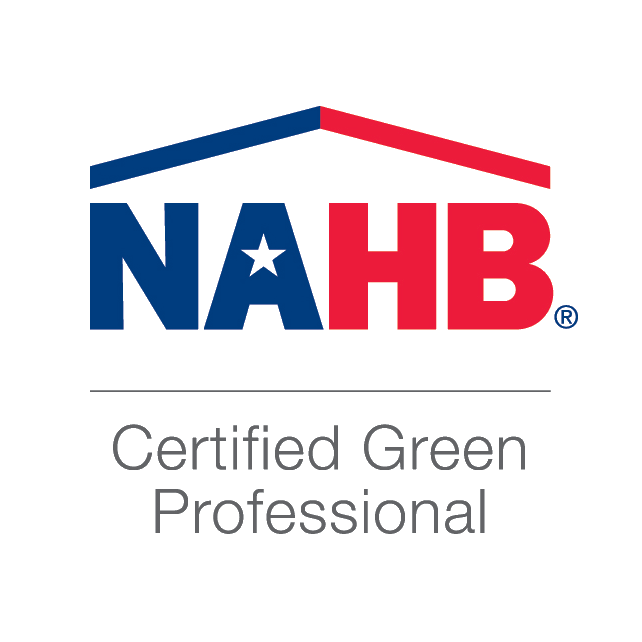Craftsman-style limewashed brick home.
Brick has been a popular building material for thousands of years — since around circa 4000 BC or even earlier. Other than stone, it is one of the strongest, most durable substances for construction. And throughout history, builders have applied various treatments to the surface of the brick, often to protect it from weathering.
Today, many luxury homeowners are rediscovering the joy of various brick-washing techniques for the aesthetic. In this post, we’ll discuss German schmear/German smear, mortar wash, limewash, and whitewash. We’ll also hit on other options like painting and staining brick, as well as brick options that come with pre-done effects so you can decide which one is best for you.
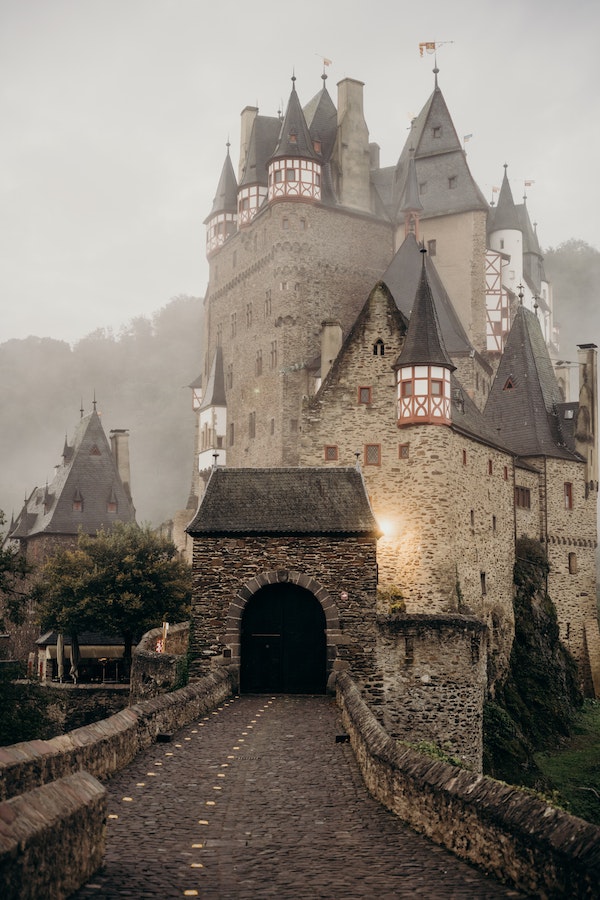
European castle with German schmear brick walls.
What Is German schmear/German schmear or mortar wash?
All three of these terms refer to the same thing. German schmear, (the German way of spelling, “smear”), is a finishing technique for brick that involves smearing mortar over the face of a brick or stone wall surface.
The mortar wash on brick exterior houses provided excellent rain, wind, and UV protection for brick homes centuries ago without interfering with the breathability of the brick walls.
Why do people use German schmear on their houses today?
This effect provides an old-world German cottage or European castle look that many homeowners find nostalgic and charming. It connotes a sense of connection to past weather-worn construction that stands the test of time.
Most of all, it adds character to new construction to give a welcoming feeling rather than an institutional, cold, or impersonal atmosphere.
Not only can you German smear your house exterior, but you can also enjoy a German smear fireplace or interior brick walls. This look goes well with Farmhouse-style, Craftsman-style, Industrial-style homes, and more. Another option? German smear on stone.
How to do German schmear on a brick house
To do a proper mortar wash, apply wet mortar over a wet brick or stone wall and then wash some of it off with a wet sponge or hose so that the mortar doesn’t completely cover the wall material. You can choose whether to leave a very heavy or thinner coat of mortar depending on the effect you like best.
For best results, hire professionals who are experienced with applying German schmear.

Mortar washed brick fireplace in living space with rustic ceiling beams and large iron chandelier.
What are the pros and cons of German Schmear on brick?
Advantages of German schmear/mortar wash
German schmear on a brick wall (or mortar wash) adds a lot of texture and character. The aesthetic is unique and far from looking like a “cookie-cutter” home.
This effect is perfect for creating a rustic or distressed look, which many people appreciate today as they seek to blend modern, new technology with reclaimed wood, natural stone, and other earthy elements in their home’s architecture.
This option doesn’t require much maintenance. Even as it weathers over time, it looks great.
Mortar wash can partially cover your brick, softening strong lines and creating greater irregularities.
German schmear can be used inside on brick fireplaces or walls, as well. Without being exposed to the elements, you can expect your mortar wash to look consistently amazing over many years.
This technique protects your brick from weathering and is also breathable.
The mortar coating lasts a lot longer than paint or whitewash and requires very little maintenance.
Disadvantages of German schmear/mortar wash
Mortar wash, once it is dry, is extremely difficult to remove. Consider it to be a permanent decision. Muriatic acid may be able to take the mortar off with a lot of scrubbing, but it’s best for the health of your brick to plan to leave the mortar wash on.
How long does German schmear last?
German schmear is a permanent treatment and may weather but will continue to last. Some people may, eventually, want to freshen up their look. But many people find that they love the look even more with weathering and age.
One of the beautiful things about this effect is that it doesn’t have to look perfect and isn’t supposed to be uniform. So it may not ever need touching up or maintenance in your lifetime.
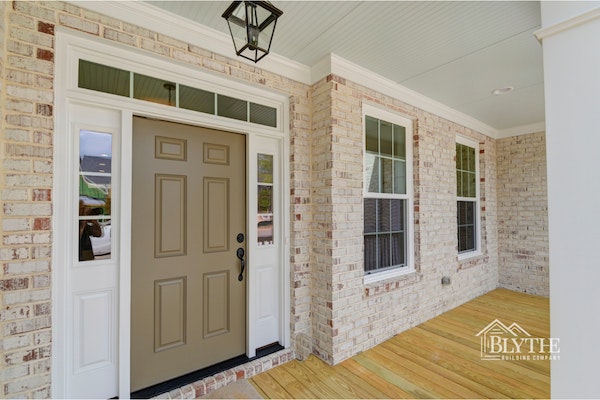
Limewashed red brick home.
What is limewash for brick?
Limewash (or limewash paint for brick) is a technique to partially cover brick or stone with a chalky paste made from crushed limestone and water. It’s perfect for adhering to the porous surfaces of brick, creating a natural, “organic” effect.
What is the difference between German smear vs. limewash?
Limewash and German smear use a similar technique but different materials. Limewash is ground limestone and water. German Smear involves wet mortar.
How to limewash brick
Similar to a mortar wash/German schmear, you paint on the brick limewash paste over your (wet) brick wall surface with a masonry brush.
Then after 30-45 minutes or so, use a hose or wet sponge to remove some of the limewash so that the brick or stone shows through.
Ideally, apply it on an overcast day to prevent it from drying faster than you’d like. And make sure that you avoid temperature extremes during the application.
For best results, bring in the pros.

Limewashed brick fireplace in a great room with vaulted ceiling, rustic hickory hardwood floors, and custom built-ins.
What are the pros and cons of limewash on brick?
Limewash advantages
It is chalky and breathable, which means moisture doesn’t get trapped inside of your brick the way it can with certain types of paint. (Although, if you choose the right paint for brick, that shouldn’t be an issue.)
Limewash on a brick house acts as a natural fungicide, preventing mold and mildew issues. It is quite water-resistant.
Covering brick with limewash helps to protect the brick from weathering and damage. It sinks deeply into the porous surface of the brick, bonding firmly to it.
It is an environmentally-friendly choice.
Lime mortar, unlike some other options, can be removed within 48 hours after application, in most cases.
Limewash is extremely low-maintenance. Many people even prefer the look as it ages over time.
It has a beautiful matte finish that is light and airy. It has a softer look than mortar wash.
Lime “paint” for brick is available in different tints and colors.
Limewash is often much less expensive than paint.
Limewash, like mortar wash, can last much longer than whitewash or paint.
Limewash disadvantages
Within a couple of days, limewash becomes very permanent.
This substance, once dried, can be a bit chalky and powdery to the touch.
If you feel that the look becomes too faded over many years, you may decide to reapply a new coat of limewash.
How long does limewash last?
The amount of time limewash will last depends on your type of brick, the weather and climate, how thick your initial application was, and what aesthetic you prefer. On an interior application, a limewash brick fireplace, for example, can last almost indefinitely, without weathering.
The limewash calcifies to your brick walls, then goes through an aging process called “patina” over time.
Limewash can last for many years, possibly even decades, particularly if you enjoy the look of it as it ages, which many people do.
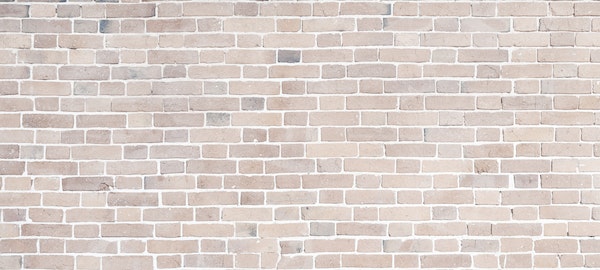
A whitewashed brick wall. Note how the colors of the red brick are softened.
What is whitewash for a brick house?
Generally, the definition of whitewash is to apply a watery paint solution to a brick or stone surface. If you whitewash your brick house, it provides a similar effect to mortar washing or limewashing, however, no mortar is involved in this technique. You can even whitewash wood or stone, as well. This look is great for interior and exterior applications.
What is the difference between German schmear vs. whitewash?
The difference between painting brick and whitewashing is that whitewashing allows some of the natural color and texture of your brick to show through. It is more of a translucent, thin film rather than the opaque and smooth look of paint.
Think of the glaze on a Krispie Kreme doughnut rather than buttercream frosting.
How to whitewash brick
Whitewashing brick often simply involves using white latex paint that is thinned with water (half and half, or whatever consistency you prefer) and then brushed or rolled over the brick surface. Apply until you get the level of coverage you desire.
You may want to use an old rag to wipe away any excess paint. Sometimes, this may take a few coats of your whitewash paint.
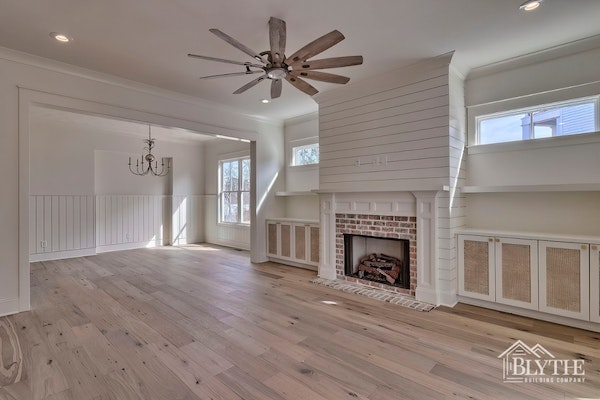
Whitewashed brick fireplace surround with custom built-ins on each side and rustic hardwood floors.
Pros and cons of whitewash
Advantages of whitewash on brick
Whitewashed brick, although fairly permanent, is easier to remove than mortar wash or limewash. It can potentially be power washed away, sandblasted off, or chemically stripped. But if you do want to remove it, leave that to the professionals to avoid damaging your valuable brick.
Whitewashed brick looks more uniform with less chunky, rough texture than some of the other brick washing techniques.
You can pick from a wide range of color options. It doesn’t have to be white!
Whitewash often lasts longer than paint.
Disadvantages of whitewash on brick
Most likely, you will want to touch up the whitewash after many years or do some maintenance because it is not as permanent as mortar wash or limewash.
If you don’t choose breathable paint, you can end up with moisture problems.
How long does whitewash last?
Whitewash can last for many years, even up to twenty or so. Especially if you like the look of the aging process. If you decide you want to freshen up your whitewash at some point, it’s easy to apply another coat or two later.
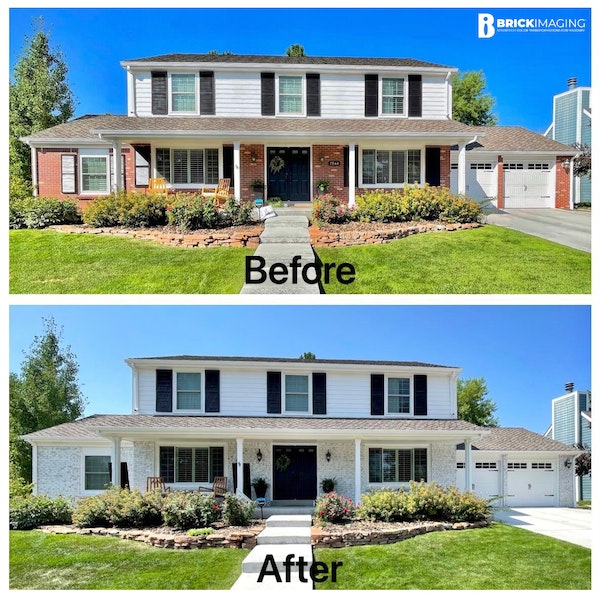
A brick staining before and after image courtesy of brickimaging.com
A brief overview of other brick finishing methods
Staining brick
Brick staining doesn’t cover the texture of your brick at all. It’s almost just like changing the color of your brick to be something new on the surface. The mortar can remain the same color as before, or you can stain the mortar, too.
If you are building a new luxury home, you could stain your brick, but in many cases, you can just buy brick that is the color you desire.
However, if you want to change the color of your brick later, then staining may be a good option. Or, if you want a color that isn’t easily available in unstained brick, staining may be for you. Some homeowners just love the unique looks they can achieve through staining and choose it for that reason.
For example, some people choose to stain certain bricks for a staggered, random pop of a different color. Or you could use two different stains to highlight certain brickwork or areas of the architechture.
Advantages and disadvantages of staining brick
Pros of brick staining
Stain lasts a very long time. It is considered to be permanent. Some stains are warrantied not to bubble, chip, or flake due to moisture for 15 years. Some even offer a lifetime guarantee for brick stain when they apply it if the masonry remains unaltered.
Depending on your climate, weather conditions, and the type of brick you have, it can last two decades, or even longer. The stain will never really go away. The color will stay there until you change it with a new stain, paint, or other effect.
Stain is affordable over time because there is really no maintenance involved.
Cons of brick staining
Stain can be almost impossible to reverse, so it is a rather permanent decision. You can still apply another stain later or paint the brick. But you may not be able to remove stain once it is applied.
The brick has to be very clean for the stain to absorb properly during application.

White painted brick back porch and masonry, wood-burning fireplace.
Painting brick
Painting creates a more uniform effect that is much more smooth than the other types of brick finishing techniques. It is a very popular technique for many luxury clients in 2022.
If you do paint brick, be sure to do your research and only invest in the highest quality, breathable paint for longer life. Then you won’t have to worry about moisture being trapped in the brick.
Keep in mind that, over time, paint may require a bit more maintenance than some of the other brick washing options.
If you are thinking about going the painting-your-brick route, check out our post on Should You Paint a Brick House? here. This topic deserves a focused discussion with all the pros and cons.
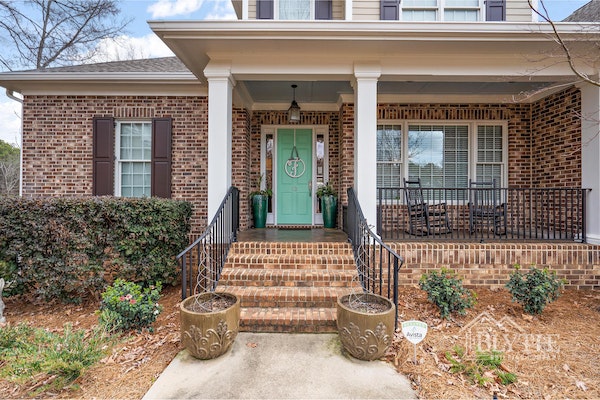
Leave your brick “as is”
All the possible methods of washing, painting, or staining brick are great. We support our luxury home clients who want to do any of these things. And, of course, we love the look of “natural” brick, too.
Also, keep in mind that many types of brick come with effects on them already. So check with your builder about your options before committing. Here are some examples from Cherokeebrick.com, one of our trusted vendors.
Brick without any finish at all is strong, durable, and extremely low-maintenance. Many colors and styles are available to give your home a unique appearance.
Whatever kind of brick finish you like, we celebrate your style with you.
Be on the lookout for a post next month about messy mortar, another popular effect where the mortar adds a lot of character to your brick home.
Ready to build a German schmear house or any other type of specialty brick finish on your new dream home?
We’d love to partner with you to build your luxury home in Lexington, SC or the Greater Columbia, SC area.
Lee Blythe is a Certified Master Builder and our company has built over 100 custom homes in the Midlands of South Carolina.
Contact us today and let’s get started.
We build homes in areas like Lexington, Lake Murray, Irmo, Chapin, Lake Carolina, downtown Columbia, and Pine Ridge.
Related
Should You Paint Your Brick House in 2022?
Is a Brick Backsplash Right for Your Kitchen? Pros and Cons
8 Ways Reclaimed Wood Can Add Character to Your Home







